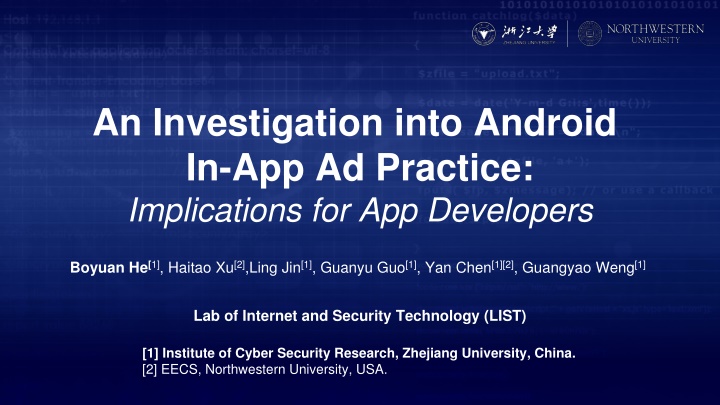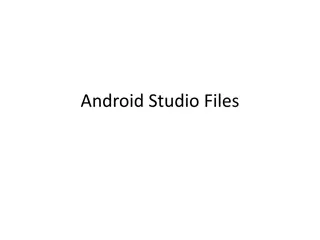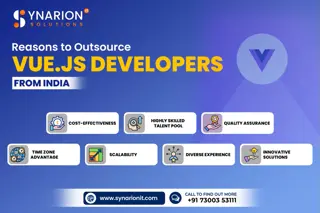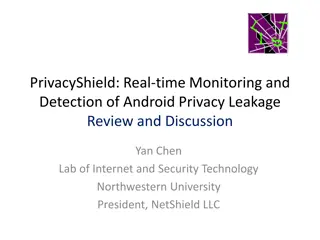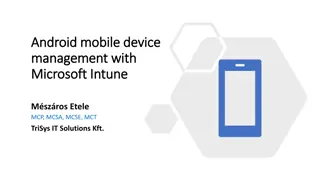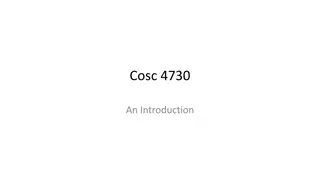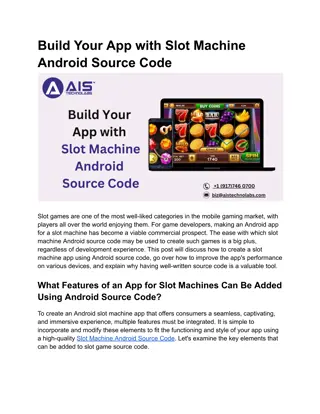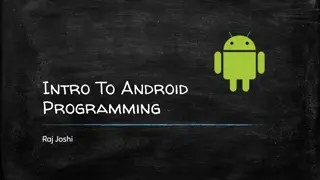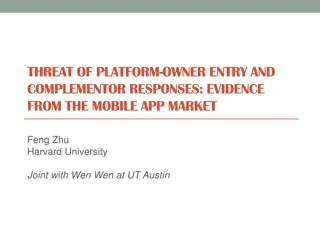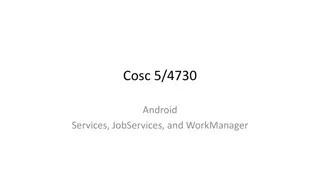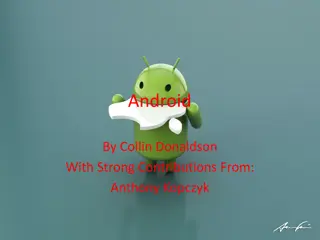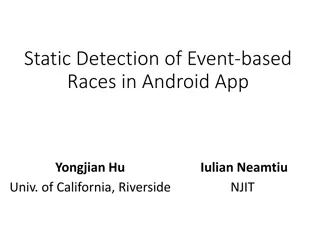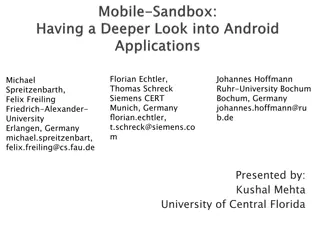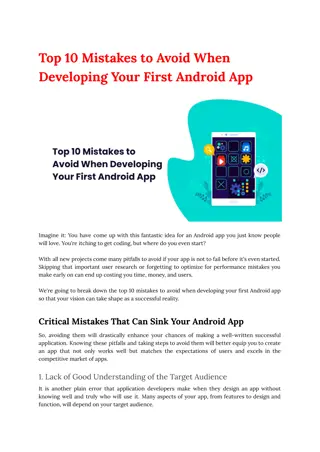Android In-App Ad Practice: Implications for Developers
An investigation into the world of Android in-app advertising sheds light on popular ad practices and networks. From app monetization to third-party ad platforms, developers are navigating a complex ecosystem to drive revenue through in-app ads. Learn about top ad networks, ad integration methods, and the evolving landscape of in-app advertising.
Download Presentation

Please find below an Image/Link to download the presentation.
The content on the website is provided AS IS for your information and personal use only. It may not be sold, licensed, or shared on other websites without obtaining consent from the author.If you encounter any issues during the download, it is possible that the publisher has removed the file from their server.
You are allowed to download the files provided on this website for personal or commercial use, subject to the condition that they are used lawfully. All files are the property of their respective owners.
The content on the website is provided AS IS for your information and personal use only. It may not be sold, licensed, or shared on other websites without obtaining consent from the author.
E N D
Presentation Transcript
An Investigation into Android In-App Ad Practice: Implications for App Developers Boyuan He[1], Haitao Xu[2],Ling Jin[1], Guanyu Guo[1], Yan Chen[1][2], Guangyao Weng[1] Lab of Internet and Security Technology (LIST) [1] Institute of Cyber Security Research, Zhejiang University, China. [2] EECS, Northwestern University, USA.
App Monetization 87.7% 37.9% Global OS market share (Mar.17) Mobile OS market share (Q2 17) 92.5% 1.3Million 2.9Million Ratio of free apps in Google Play Android developers (Oct. 2016) Apps in Google Play (Feb.17) HOW TO MONETIZE A FREE APP? IN-APP ADVERTISING!
In-app Advertising Popular In-app advertising is getting popular today. Ad Platform Big app vendors have their own advertising platforms, and are always easy to find advertisers to pay. (E.g. YouTube and Facebook) Third-party Ad Network Developers need a third- party Ad networks!
In-app Advertising In-app advertising ecosystem: advertisers, ad networks, developers and users. Advertiser Users Launch an advertising campaign. Show ads to users in their apps. Aggregate ad inventory Developers (Publishers) Ad Network
AD Network Ad Network Server Ad Request Ad Library Ad Response
Ad Network Ad integration via Java APIs A banner ad from Google Admob is added by calling Java APIs of ad network. Ad integration via XML files A banner ad from Google Admob is added by changing XML layout file.
In-app Advertising Top 10 ad networks with different features in 2017 Ad Network Admob AdColony Airpush Chartboost Fyber Inmobi Leadbolt RevMob Startapp Tapjoy Supported Ad Types Native, Video, Interstitial Rich Media, Video App Icon, Messaging, Notifications, Offerwall Content Lock, Interstitial, OfferWall, Video Interstitial, Native, Video Banner, Native, Video, Interstitial, Rich Media Native, Video, Interstitial Interstitial, Video, Pop-up, Rich Media App Icon, Full Page Ads, InApp Ads, Interstitial, Video Content Lock, Interstitial, Offerwall, Rewards
Motivation What is the best ad practice in a free app? 1. What is the trend in ad networks used in recent years? 2. Can in-app advertising jeopardize user experience 3. Are there any patterns in different co-existed ad types within the same app? 4. How many ad networks within an app can be considered as acceptable to users? 5. What are the popular ad types? What are the ad types that user are more likely to tolerate?
Contributions Our research makes the following contributions: 1. To the best of our knowledge, we are the first to provide practical guidelines for mobile developers to monetize their apps through third-party in-app advertising. 2. We are the first to measure third-party in-app advertising in Android apps at API granularity. 3. We are the first to provide a unified classification system for mobile in-app ads, and measure the impact of different ad types on various properties of apps.
Ad Classification Based on UI behavior, we divide mobile ad into the following 5 types: 1. Offerwall ad. 2. Popup ad. 3. Notification ad. 4. Floating ad. 5. Embedded ad. Offerwall ad Popup ad Notification ad
Ad Classification Furthermore, we assign different aggressiveness level to each ad type. Ad type Aggressiveness level Offerwall High Popup Low Notification High Floating Low Embedded Low Floating ad Embeded ad
System Design of MadLens 1. App data collection. 2. Ad network identification. 3. Ad network API mapping. 4. Ad detection. Ad Network SDK Docs Ad Network API Dataset Ad Network API Mapping Android App Dataset Ad Network Dataset Module Analysis Static Analysis Report
App Data Collection Our app dataset includes 277,616 free Android apps from Google Play (Mar. 2017). Our app dataset covers all 48 categories of apps. For each app, we collect the apk file as well as meta information (e.g. descriptions, # of downloads, ratings and reviews).
Ad Network Identification Two important observations Popular ad libraries (ad network modules) are shared by many apps. So code clones can be detected in these apps. The code logic in ad libraries are relatively independent, and ad libraries usually interact with apps via ad network APIs. Module analysis Static analysis and clustering techniques are employed to measure the coupling of different modules inside an app. Map code clusters to ad libraries.
Ad Network API Mapping API mapping Documentation from ad networks are used to map specific ad APIs to a certain ad type. Dynamic analysis are used to verify the behavior of the ad API call. Ad network API dataset In all, we collect 697 unique ad APIs in our ad network API dataset. Embeded Popup Floating Notification Offerwall Total # of APIs 407 200 10 29 51 697
Ad Detection We take a static approach for ad detection, and use Androguard as static analyzer. 1. Unpack apk file to extract all the resources files and configuration files. 2. Covert code in dex file to Smali code for further analysis. 3. Match ad network API patterns in both XML and Java files. Our static analysis is resistance to many apk obfuscation and hardening techniques.
Result The Trend in # of ad libraries in an app. 2008-2009: barely have ad library. 2010-2014: 25% have at least 1 ad library. 2015-2017: 50% have at least 1 ad library, and 25% have at least 2 ad libraries.
Result The Trend in # of ad libraries in an app. 37.8% have no ad library. 33% have 1 ad library. 10% have 2 ad libraries. 5% have 3 ad libraries. Implication1: Developers have more choices about ad networks than several years before. Most developers are conservative about ad placement in their apps given the observation that about 71% apps contain at most one ad library.
Result Prevalence of ad types in an app Offerwall: 8.2%. Popup: 55.1%. Notification: 0.1%. Floating: 0.6%. Embedded: 61.7%. Both of Embedded & Popup: 54.7%. 62.2% have at least 1 ad type. 8.5% have more than 2 ad type. Implication2: Statistically, developers include two lowly aggressive ad types, Embedded and Popup, simultaneously in more than a half of their apps. The two highly aggressive ad types including Offerwall and Notification are not popular.
Result Prevalence of ad types in the apps of the top 10 categories Business: 39.6% Education: 48.0% Tools: 48.5% Entertainment: 73.7% Music&Audio: 79.2% Personalization: 74.9% Casual: 86.7%
Result Prevalence of ad types in the apps of the top 10 categories Implication3: To some extent, the likeliness of an app containing ads depends on the app category to which it belongs Thus, developers may decide the ad placement issue based on the category of their own apps. Implication4: the two lowly aggressive ad types, Embedded and Popup, are popular with apps in nearly all categories.The highly aggressive ad type, Offerwall, is somewhat popular. Developers could consider placing these three types of ads in their apps.
Result Correlation between in-app ads and app rating from user. Implication5: Developers should avoid embedding too many ad libraries into an app, empirically no more than 6, which otherwise would anger the app users and result in bad ratings.
Result Ad network choice for apps in the different stage of their lifecycle Implication6: A developer should use at most one ad network when her app is still at the initial stage and could start using more (2 or 3) ad networks when the app becomes popular, reflected by its downloads.
Result Ad type choice for apps in the different stage of their lifecycle Implication7: A developer should mainly place Embedded and Popup ads on her app in whatever lifecycle stage, and could start to place Offerwall ads when her app has many enough downloads.
Summary Propose a unified methodology of ad classification based on UI behavior. Design and implement MadLens, a framework for fine-grained and large-scale Android in-app ads analysis. Provide insights for developers about how to optimize their app monetization with optimal ad placement choices.
